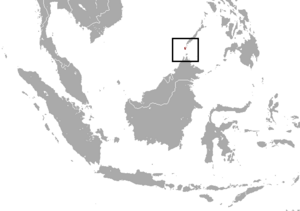Philippine mouse-deer facts for kids
Quick facts for kids Philippine mouse-deer |
|
|---|---|
 |
|
| Conservation status | |
| Scientific classification | |
| Genus: |
Tragulus
|
| Species: |
nigricans
|
 |
|
| Synonyms | |
|
Tragulus napu nigricans |
|
The Philippine mouse-deer (Tragulus nigricans), also called the Balabac chevrotain or pilandok in Filipino, is a small, nocturnal animal. It is a type of ruminant, which means it chews its cud, like a cow. This special animal lives only on the island of Balabac and some smaller islands nearby in the Philippines.
The name Tragulus means 'little goat'. The mouse-deer got this name because of its eyes, which have horizontal pupils. These pupils help it see more around it. Even though it's called a mouse-deer, it's not a true deer. It belongs to the chevrotain family. These are some of the smallest hoofed mammals in the world. For a long time, people thought it was a type of greater mouse-deer. But in 2004, scientists found it was its own unique species.
Contents
What Does the Philippine Mouse-Deer Look Like?
The Philippine mouse-deer has a coat that is black and brown. It has white stripes on its throat and chest. Each hair on its body has different colors, making its coat look special. The hair is light at the bottom, then has a tawny or orange middle, and a black tip.
Special Markings
The most noticeable marks are on its throat. It has three thin white stripes that start from a white patch under its chin. These stripes go down towards its chest. The rest of its throat is very dark, almost jet black, which makes the white stripes stand out. Sometimes, the black color can even cover the stripes.
Its head is usually darker than its body. It has wide, reddish-brown stripes that look like eyebrows. These go from the front corners of its eyes to the base of its ears. The top of its nose and forehead are dark brown. The sides of its head are more reddish. It also has a special bare patch under its jaw, outlined in white.
Size and Features
This mouse-deer has thin legs and a curved back. Its fur is brown with a white base. A dark line runs from each ear, past the eye, towards the nose. The Balabac mouse-deer is about 40 to 50 centimeters (16-20 inches) long from head to tail. It stands about 18 centimeters (7 inches) tall at its shoulder.
Male mouse-deer do not have antlers like true deer. Instead, they have large, tusk-like canine teeth on their upper jaw. They use these teeth to defend themselves or to fight with other males over their territory.
How the Philippine Mouse-Deer Lives
The Philippine mouse-deer is a shy animal that usually lives alone. It is nocturnal, meaning it is most active at night. Sometimes, it might be seen in pairs for short times. Its main food is leaves, flowers, and other plants found in the thick forest.
During the day, it hides in dense forests. It tries not to move much. When the sun goes down, it comes out to feed. It might go into mangrove areas or more open spaces. They have even been seen near the seashore.
Reproduction and Life Cycle
The Philippine mouse-deer grows up quickly. It is thought to be able to have babies when it is about 5 months old. These animals usually have one baby at a time, but very rarely, they might have two. The mother carries the baby for about 140 to 177 days. The mouse-deer is estimated to live for about 14 years.
The Mouse-Deer in Culture
In Philippine folklore, the Philippine mouse-deer is often shown as a trickster. This means it is a clever character who plays tricks on others. In a story from the Maranao people, the mouse-deer tricks a prince. It makes the prince give up his bag of gold and face a hive of angry bees.
The mouse-deer is also seen as a wise protector of nature. It uses its smarts to fight against those who harm forests, seas, and wildlife. Because of this, Filipino Muslims, especially the Molbog people of southern Palawan, think the mouse-deer is a sacred animal.
Protecting the Philippine Mouse-Deer
The Philippine mouse-deer is in danger for several reasons. People hunt it illegally, and some try to capture it for the wild animal trade. Its meat is considered a special food on the islands, and its skin is used to make leather. Hunters have said that it is becoming harder to find these mouse-deer.
The biggest threat to the mouse-deer is habitat loss. Its home is being turned into farms for coconut trees and other crops. Even though Philippine law protects the mouse-deer, these laws are not always enforced well.
The Philippines has special protected areas called priority sites. However, the Philippine mouse-deer does not live in any of these protected areas. This means it does not benefit from the protection they offer.
Philippine Mouse-Deer in Zoos
Outside of the Philippines, you can only find Philippine mouse-deer in a few zoos in Europe. One of the most well-known places to see them is at Chester Zoo.
Images for kids




